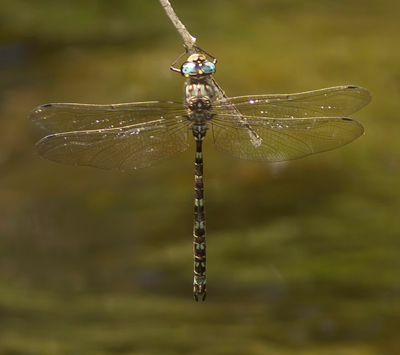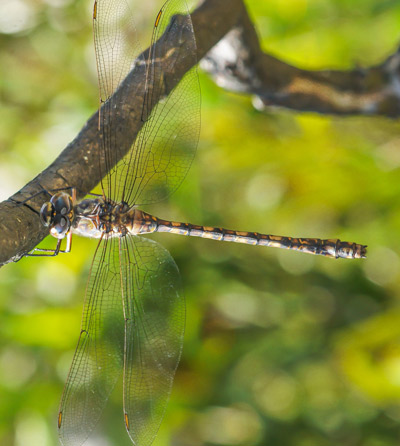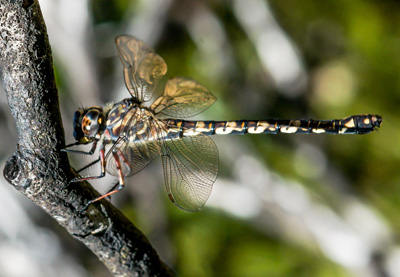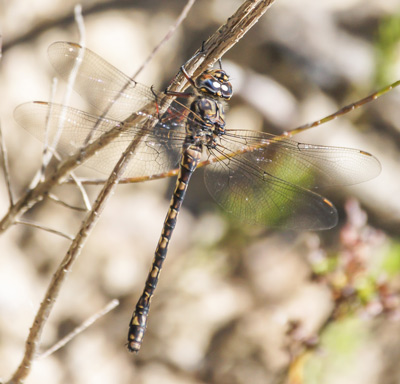Austroaeschna subapicalis (Theischinger, 1982)
CONEHEAD DARNER
Family Telephlebiidae

A male Conehead Darner at the Little Styx River near the New England National Park NSW on January 25th 2015.
The summer of 2015 had been mostly wet or cloudy so when the morning dawned at least partly sunny I decided to set off towards the Point Lookout entrance of the New England National Park some dragonflies that I had not yet photographed. There were several Darners on my to-find list and I knew some had been recorded in this area. I stopped at a number of creeks on the way but it wasn’t until I reached the Little Styx River – really a little creek at this point, that I spotted a Darner that could have been a different one. It was patrolling a short stretch of stream next to the road. I had no luck photographing it while in flight. Eventually it landed and I managed a couple of shots before it flew off again. It moved further up the stream once again patrolling before landing once more on an overhanging branch, but was too far away to photograph. It seemed quite wary of me following it and disappeared entirely. This Darner was a new one for me, an Austroaeschna subapicalis, the Conehead Darner.

Top view of a female Conehead Darner at Katoomba NSW on December 14th 2014. Photographed by Kerrie O’Donnell.

Side view of a female Conehead Darner at Katoomba NSW on December 14th 2014. Photographed by Kerrie O’Donnell.
A friend sent me some photographs of a dragonfly she photographed near a waterfall in Katoomba NSW that she had not yet identified. If you look closely behind the eyes in 2 of her photographs you can see the rounded back edge of the occipital triangle flanked on each side be a smaller rounded lobe, which is a distinctive feature of the female Conehead Darner. Kerrie O’Donnell has kindly let me use the photographs on this page.
Austroaeschna subapicalis (Theischinger, 1982) CONEHEAD DARNER Family Telephlebiidae


The summer of 2015 had been mostly wet or cloudy so when the morning dawned at least partly sunny, I decided to set off towards the Point Lookout entrance of the New England National Park to look for some dragonflies that I had not yet photographed. There were several Darners on my to-find list and I knew some had been recorded in this area. I stopped at a number of creeks on the way but it wasn’t until I reached the Little Styx River – really a little creek at this point – that I spotted a Darner that could have been a different one. It was patrolling a short stretch of the stream next to the road. I had no luck photographing it while in flight. Eventually it landed and I managed a couple of shots before it flew off again. It moved further up the stream once again patrolling before landing once more on an overhanging branch, but it was too far away to photograph. It seemed quite wary of me following it and disappeared entirely. This Darner was a new one for me, an Austroaeschna subapicalis, the Conehead Darner.
This Darner was a new one for me – an Austroaeschna subapicalis, the Conehead Darner.
In January 2018 I noticed a pale dragonfly flying just above the water in a creek at Deer Vale, very late in the afternoon. As the light was very dull it was almost impossible to capture a photo, although I had been trying over a few afternoons. As a friend and I were watching this dragonfly going up and down, it landed on the trunk of a t-tree in a small patch of sun. I was surprised to see it was a lovely blue marked Conehead Darner – the 2nd sightingof this species for me.

A friend sent me some photographs of a dragonfly she photographed near a waterfall in Katoomba NSW, that she had not yet identified. If you look closely behind the eyes in 2 of her photographs you can see the rounded back edge of the occipital triangle flanked on each side be a smaller rounded lobe, which is a distinctive feature of the female Conehead Darner. Kerrie O’Donnell has kindly let me use the photographs on this page.


Spot the dragonfly! Quite a number of darners seem to like flying up and down our little creeks from late afternoon to dusk on hot summer days. This habitat photo was taken with the equivalent of a 24mm lens.


